Casey Johnson Authors Cover Story of OCTLA’s The Gavel: Navigating the Waters of Pool Injury Cases
August 18, 2016
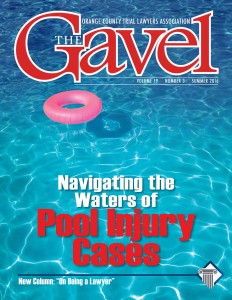
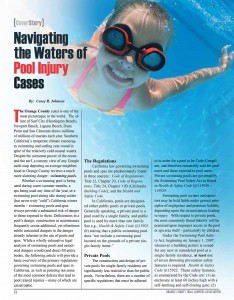
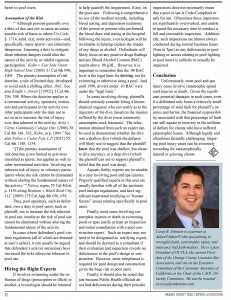
When catastrophic injuries and drownings take place in private and public pools, who is held accountable?
Incredibly informative and expertly crafted by Aitken Aitken Cohn’s own Casey Johnson, the cover story of the Summer 2016 OCTLA The Gavel highlights the complexities in handling pool injury cases. Titled “Navigating the Waters of Pool Injury Cases,” Casey dives into providing his fellow colleagues and readers with “a basic overview of the primary regulations governing swimming pools and spas in California, as well as pointing out some of the most common defects that lead to pool related injuries.” Check out the full article below:
Navigating the Waters of Pool Injury Cases
(As published in The Gavel, Summer 2016)
By: Casey R. Johnson
The Orange County coast is one of the most picturesque in the world. The allure of Surf City (Huntington Beach), Newport Beach, Laguna Beach, Dana Point and San Clemente draws millions of millions of tourists each year. Southern California’s temperate climate encourages swimming and surfing year round in spite of the relatively cold coastal waters. Despite the awesome power of the ocean and the surf, a cursory view of any Google earth map depicting an average neighborhood in Orange County reviews a much more alarming danger: swimming pools.
Whether a swimming pool is being used during warm summer months, a spa being used any time of the year, or a swimming pool sitting idle during colder (but never truly “cold”) California winter months – swimming pools and spas always provide a substantial risk of danger to those exposed to them. Deficiencies in a pool’s design, construction or maintenance frequently create additional, yet oftentimes subtle concealed dangers to the danger already inherent in the use of pools and spas. While a wholly exhaustive legal analysis of swimming pools and associated dangers would (and does) fill entire books, the following article will provide a basic overview of the primary regulations governing swimming pools and spas in California, as well as pointing out some of the most common defects that lead to pool related injuries – many of which are catastrophic.
The Regulations
California law governing swimming pools and spas are predominately found in three sources: Code of Regulations, Title 22, Chapter 20; Code of Regulations, Title 24, Chapter 31B (California Building Code); and the Health and Safety Code.
In California, pools are designated either public pools or private pools. Generally speaking, a private pool is a pool used by a single family, and public pool is used by more than one family. See e.g., Health & Safety Code §115921 (b) stating that a public swimming pool does “not include a swimming pool located on the grounds of a private single-family home.”
Private Pools
The construction and design of private pools for single-family residents are significantly less restrictive than for public pools. Nevertheless, there are a number of specific regulations that must be adhered to in order for a pool to be Code-Compliant, and therefore reasonably safe for pool users and those exposed to pool areas. Private swimming pools are governed by the Swimming Pool Safety Act as found in Health & Safety Code §§ 115920 – 115929.
Swimming pool owners and operators may be held liable under general principles of negligence and premises liability, depending upon the circumstances leading to injury. With respect to private pools, the most commonly found liability will be premised upon improper access to the pool or spa area itself – particularly by children.
Under the Swimming Pool Safety Act, beginning on January 1, 2007, whenever a building permit is issued for any new or remodeled pool at a single-family residence, at least one of seven drowning prevention safety features is required. Health & Safety Code §115922. These safety features, as enumerated by the Code are: (1) an enclosure at least 60 inches high with a self-latching and self-closing gate; (2) mesh fencing with a self-closing and self-latching gate that can accommodate a key lockable device; (3) a safety pool cover; (4) exit alarms on door providing access to the pool; (5) doors providing access from the home to the pool must be equipped with a self-closing, self-latching gate; (6) swimming pool alarms that detect unauthorized entrance into the water; and (7) other means of protection, if it is equal to or greater than those set forth in (1)-(6). Health & Safety Code §155922(a)(1)-(7).
Specifically exempt from these requirements are public swimming pools (which must abide by further, additional requirements) and hot tubs or spas with locking safety covers. Health & Safety Code §115925.
While the Code requires at least one safety feature for issuance of a building permit, this requirement should not be substituted for the “standard of care.” Depending on the circumstances leading to injury, it may be appropriate to argue that more than one such safety feature should be adopted in order to make a pool reasonably safe, particularly when balanced against the catastrophic nature of many pool injuries – drowning resulting in permanent brain injury or death. This is particularly true if the pool owner or operator have advanced notice of unwanted access to the private pool or spa.
Similarly, it may and should be argued that even if a private pool was designed, constructed and/or approved for use prior to January 1, 2007, one or more of the drowning prevention safety features set forth in Health & Safety Code §155922(a)(1)-(7) may nevertheless be required for a pool to meet the modern standard of care and render a pool reasonably safe for use.
Statistics confirm that in Orange County alone, a drowning occurs every nine (9) days, with the majority of those occurring in community and private pools and Jacuzzis. Whiting, David “Someone Drowns in Orange County Every 9 Days April 12, 2015, Orange County Register. Proper supervision of young children, using the buddy system as adults, and not swimming while under the influence all greatly reduce the chances of drowning or near-drowning, whether or not the fences and other prevention methods delineated in Health & Safety Code §155922(a)(1)-(7) have been implemented.
Public Pools
Public pools are subject to much more particular safety requirements. This makes sense from a very practical standpoint, as such pools are generally used more regularly and by greater numbers of people. It is important when evaluating whether a public pool is Code-Complaint that the pool being analyzed is being considered relative to the applicable regulations. This will normally be determined by the date the pool was certified for use. One exception to this are the pool and spa drain cover standards codified by the Virginia Graeme Baker Pool and Spa Safety Act, which although enacted in 2007, are applicable to all pools, regardless of when they were constructed. See e.g. 24 CCR 3160B-3162B. These regulations were adopted in response to numerous drownings caused when the suction from a pool or spa drain entrapped individuals, usually children, underwater. All pools, irrespective of when they were constructed, and whether they are a private or public pool, must comply with the Virginia Graeme Baker Pool and Spa Safety Act.
Pool Operations
22 CCR Chapter 20 – Public Swimming Pools, sets forth the requirements for proper pool operation. These include regulations for records of pool operations, clarity of water and pool cleaning and chemical use. These regulations are primarily directed at ensuring that the pool water is safe to swim in, and clear so that pool users may be observed while in the pool (and that individuals outside of the pool can safely observe those in the pool, and can clearly see if someone is experiencing problems while swimming). Any attorney contacted regarding a drowning should immediately seek to preserve, and ultimately obtain all of the pool maintenance records. This is particularly true in any case where there is an allegation that the pool water was cloudy and that the cloudy water caused a delay or complete inability of those outside the pool to see those swimming inside the pool. Even a delay of seconds can be the difference between life and death, and failure to comply with pool cleaning and water clarity regulations could substantiate the powerful use of a negligence per se instruction.
Pool & Spa Design and Construction
While deficiencies can be found in pool operation – particularly relating in inadequate record maintenance, Code of Regulations, Title 24, Chapter 31B (Building Code) speaks more generally to the specific requirements of pool construction and pool maintenance, including the physical structures, and the overwhelming majority of safety feature and warnings required for a public pool in California.
Plaster Color
24 CCR 3106B.3 requires that only white plaster be used in public pools, except for lane and other required markings, handholds, copings, the top surface edges of benches and the edge of spa steps. For aesthetic reasons, and to make the pool look deeper, colored plaster may be preferred. Like the regulations relating to pool operation and water clarity, the purpose of the regulation is to ensure that those outside the pool can clearly observe pool users. An exception exists for spa pools, which may be finished in a light (pastel) color other than white, if approved by the enforcing agency. 24 CCR 3106B.3, Exception.
Pool Access
Unlike private pools, public pools in California have had strict requirements for access that are applicable to all pools constructed on or after July 1, 1994. 24 CCR 3118B.3. Public pools are required to be contained within an enclosure of a specific height and spacing requirements. 24 CCR 3118B.1. In addition, access to the pool enclosure must be provided through gates that are “self-closing and self-latching” so as to keep the gate securely closed. 24 CCR3118B.2. Gates must also be “capable of being locked during times when the pool is closed.” Id. Interesting cases are presented by fact patterns that indicate after hours pool use when the access gates are “closed” but not “locked” so as to preclude their use. In the context of community pools, oftentimes residents and their guests have keys that allow them to access a pool area anytime – irrespective of posted pool hours. This poses potential liability to the pool operator, as unfettered access to the pool area completely defeats the requirement that the pool area be “locked.” With the advent of key fob systems and alternative locking designs (that allow individuals in the pool area to leave, even if the access gate is “locked” so as to remain code compliant), and single key lock system fails to actually prevent access and “lock” the pool area as intended by the regulations.
Pool Lighting
Pool lighting must also be provided for public pools that are used at night. 24 CCR 3114B.1 & 3114B.2. This includes both lighting within the pool and on the pool deck. Id., 24 CCR 3114.B.3. Pools without pool lighting must have warnings signs stating “NO USE OF POOL ALLOWED AFTER DARK.” 24 CCR 3119B.4.
In conjunction with the pool access discussion, immediately above, a pool that is otherwise code compliant (i.e. has the required in-pool and pool deck lighting and signage) during posted pool hours, may actually be in violation of the Code. This situation may arise when pool lights are set on timers to correspond with the posted pool hours. Thus, during those posted pool hours the pool would appear to be in compliance with the regulations, insofar as the lighting is on. However, if pool users are not precluded from accessing the pool beyond posted pool hours, including times when pools lights are not on, then regulatory violations should be argued. This is particularly true in public pools where the pool operators know (or should know) that after hours pool use is occurring. Detailed discovery of HOA minutes, pool operator’s letters or newsletters to pool users, and security company reports can be a treasure trove of information to help prove pool operators knowledge.
Pool Warnings
The Building Code also requires a number of warnings and safety features to provide adequate warnings to public pool users.
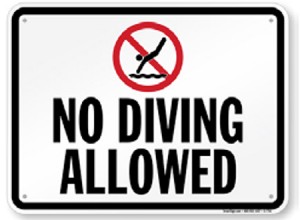
Oftentimes signs with appropriate language are posted, but are not “conspicuous” as they are hidden by pool furniture, unlit at night, or the required language is buried within a sign containing additional, unrelated language, including pool or spa capacity, bathing requirements, etc.

contrasting color” must be installed across the bottom of the pool where the water is 4 ½ feet deep. 24 CCR 3109B.2. Note that most public pools (HOA pools, community pools, etc., are less than five feet deep.
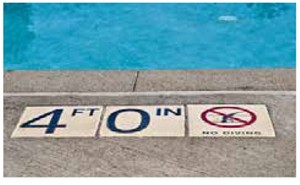
Close inspection is required for any case involving injury or death in a pool or spa to ensure that the pool or spa meets all of the relevant codes. The appropriate experts should be retained immediately and an inspection of the pool or spa conducted as close in time to the incident as possible, to avoid any allegation of changed conditions that could negatively impact your experts’ testimony. Absence of code compliance can provide you with the opportunity for a negligence per se instruction, that can be invaluable in overcoming the most common defenses raised in pool injury cases – assumption of the risk and comparative negligence.
Common Defenses in Pool Injury Cases
Intoxication/Comparative Fault
Studies have indicated that upwards of 50% of pool diving incidents involve alcohol consumption. Kluger, Y., “Diving Injuries: A preventable catastrophe.” Journal of Trauma, 36 (3): 349-351.
This, combined with the well documented impact of alcohol impairment on sensory, perceptual and performance capabilities makes intoxication an area ripe for defense arguments. However, intoxication is not a complete defense to liability, but relevant to potential comparative fault of a plaintiff.
Assuming a defendant can meet the foundational burden to show that alcohol or drugs, in some manner impacted the behavior of plaintiff, such would be presented to the jury for allocation of comparative fault, not as a complete bar to liability. Zavala v. Regents of the University of California (1981) 125 Cal.App.3d 646, 646-650.
At trial the jury will likely be instructed with both CACI 405 (Comparative Fault of Plaintiff) and CACI 404 (Intoxication), which states: “A person is not necessarily negligent just because he or she used alcohol (or drugs). However, people who drink alcohol (or take drugs) must act just as carefully as those who do not.” In the context of intoxication and pool usage no negligence per se instruction is appropriate as against an injured plaintiff, because there is no regulation prohibiting such conduct (as opposed to such an instruction in a driving under the influence situation). Particularly in situations where the pool or pool area is not code compliant, and therefore plaintiff will be entitled to a negligence per se instruction as against defendant(s), plaintiff’s intoxication bears only on the comparative fault of plaintiff – not a complete bar to liability.
Recreational Immunity
Civil Code §846 states in pertinent part: “[a]n owner of any estate or any other interest in real property, whether possessory or nonpossessory, owes no duty of care to keep the premises safe for entry or use by others for any recreational purpose or to give any warning of hazardous conditions, uses of, structures, or activities on such premises to persons entering for such purpose, except as provided in this section.”
The exceptions to the immunity provided by Civil Code §846 are broad, and explicitly set forth in the statute: “[t] his section does not limit the liability which otherwise exists (a) for willful or malicious failure to guard or warn against a dangerous condition, use, structure or activity; or (b) for injury suffered in any case where permission to enter for the above purpose was granted for consideration other than the consideration, if any, paid to said landowner by the state, or where consideration has been received from others for the same purpose; or (c) to any persons who are expressly invited rather than merely permitted to come upon the premises by the landowner.”
Identifying the exception (or exceptions) that apply to your case will be key to overcoming the defense.
An explicit invitation to use the pool or spa can be established by flyers or other promotional materials explicitly inviting pool use. Oftentimes these materials will also bring the activity within another exception (consideration). Be wary of defense attempts to characterize the consideration requirement as direct payment of a fee for entry. See e.g., Johnson v. Unocal Corp. (1993) 21 Cal.App.4th 310, 317 affirming “[a] landowner must gain some immediate and reasonably direct advantage, usually in the form of an entrance fee, before the exception to immunity for consideration under section 846 comes into play.”) For example, consideration paid by HOA members for benefits of the HOA, including pool use, should absolutely be argued as meeting the consideration exception.
The statute’s third exception for immunity applies for a defendant’s “willful or malicious failure to guard or warn against a dangerous condition, use, structure or activity.” “Willfulness” has been defined by case law as being “marked by three characteristics:
(1) actual or constructive knowledge of the peril to be apprehended;
(2) actual or constructive knowledge that injury is a probable, as opposed to a possible, result of the danger; and
(3) conscious failure to act to avoid the peril. [Citations.]” Manuel v. Pacific Gas & Electric Co. (2009) 173 Cal. App.4th 927, 940. “[W]illful misconduct does not invariably entail a subjective intent to injure. It is sufficient that a reasonable person under the same or similar circumstances would be aware of the highly dangerous character of his or her conduct. [Citations.]” (Id.) Relative to the frequent intoxication defense (discussed above) comparative negligence is not a bar to finding a defendant engaged in willful misconduct. New v. Consolidated Rock Products Co. (1985) 171 Cal.App.3d 681, 689-692; Von Tagen v. United States (1983 N. Cal.) 557 F.Supp. 256, 260.
The deep dive into discovery of what the pool operator knew, and when, can reveal long-standing knowledge of repeated code violations – the result of which poses substantial risk of serious harm to pool users.
Assumption of the Risk
“ ‘Although persons generally owe a duty of due care not to cause an unreasonable risk of harm to others Civ.Code, § 1714, subd. (a)), some activities—and, specifically, many sports—are inherently dangerous. Imposing a duty to mitigate those inherent dangers could alter the nature of the activity or inhibit vigorous participation.’ Kahn v. East Side Union High School Dist. (2003) 31 Cal.4th 990, 1003. The primary assumption of risk doctrine, a rule of limited duty, developed to avoid such a chilling effect. Ibid.; See also Knight v. Jewett [(1992)] 3 Cal.4th 296, 308. Where the doctrine applies to a recreational activity, operators, instructors and participants in the activity owe other participants only the duty not to act so as to increase the risk of injury over that inherent in the activity. Avila v. Citrus Community College Dist. (2006) 38 Cal.4th 148, 162; Kahn, at p. 1004.” See also Nalwa v. Cedar Fair, L.P. (2012) 55 Cal.4th 1148, 1154.
“[T]he primary assumption of risk doctrine is not limited to activities classified as sports, but applies as well to other recreational activities ‘involving an inherent risk of injury to voluntary participants where the risk cannot be eliminated without altering the fundamental nature of the activity.’” Nalwa, supra, 55 Cal.4th at p. 1156 citing Beninati v. Black Rock City, LLC (2009) 175 Cal.App.4th 650, 658.
Thus, pool operators, such as defendant, owe a duty to pool users, such as plaintiff, not to increase the risk inherent in pool use, insofar as the risk of pool use cannot be eliminated without altering the fundamental nature of the activity.
In cases where defendant’s pool violates regulations (all of which are directed at user’s safety), it can usually be argued that defendant’s acts (or omissions) have increased the risks otherwise inherent in pool use.
Hiring the Right Experts
If involves swimming under the influence of drugs (prescription or illicit) or alcohol, a toxicologist should be retained to help quantify the impairment, if any, on the pool user. Following a comprehensive review of the medical records, including blood testing, and deposition testimony of the person or persons who performed the blood draw and testing at the hospital following the injury, a toxicologist will be invaluable in helping explain the impact of any drugs or alcohol. Defendants will likely focus on any positive drugs findings and any Blood Alcohol Content (BAC) results above .08 g/dL. However, it is important to remember that the .08 BAC level is the legal limit for driving, not for swimming or otherwise using a pool. And until 1990, drivers under .10 BAC were under the “legal limit.”
In cases involving diving, plaintiffs should seriously consider hiring a biomechanical engineer who can testify as to the trajectory of the dive, based on the injuries suffered by the diver (most commonly catastrophic neck fractures). The information obtained from such an expert can be used to demonstrate whether the dive was a shallow dive (which the defense will likely use to suggest that the plaintiff knew that the pool was shallow, but chose to dive anyway), or a deep dive (which the plaintiff can use to support plaintiff’s belief that the pool was deep).
Aquatic Safety experts are invaluable in a case involving pool and spa injuries. Properly qualified experts in this area are usually familiar with all of the pertinent pool and spa regulations, and have significant experience testifying to “human factors” issues relating specifically to pool users.
Finally, most cases involving catastrophic injuries or death in swimming pools or spas justify at least an inspection and initial consultation with a pool construction expert. Such an expert may not need to be designated as testifying expert, and should be deemed as a consultant if their evaluation and inspection reveals no deficiencies in the pool’s design or construction. However, strict compliance is required for pool design and construction given the huge risk to pool users.
Finally, it should also be noted that just because Public Health officials do not find deficiencies during their periodic inspections does not necessarily mean that a pool or spa is Code-Compliant or safe for use. Oftentimes these inspectors are significantly overworked, and unable to spend the necessary time to conduct a full and reasonable inspection. Additionally, such inspections are almost always conducted during normal business hours (9am to 5pm) so any deficiencies in pool lighting or access relating to pool lighting or pool hours is unlikely to actually be inspected.
Conclusion
Unfortunately, most pool and spa injury cases involve catastrophic spinal cord injuries or death. Given the significant potential damages in such cases, even if a defendant only bears a relatively small percentage of total fault for plaintiff’s injuries and harms, the financial responsibility associated with that percentage of fault can still equate to recovery in the millions of dollars for clients who have suffered catastrophic losses. Although legally and oftentimes factually challenging, litigating pool injury cases can be extremely rewarding for catastrophically injured or grieving clients.

